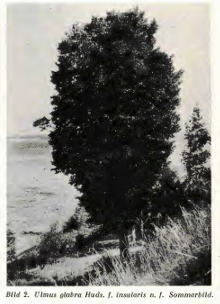
The cultivar Ulmus glabra 'Insularis' [:'island'], the Ven island elm, a fastigiate form of Wych Elm from Sweden, was identified and described by Nilsson in Lustgården 30: 127. 1949, as U. glabraHuds. f. insularis. Nilsson considered it "closely related to subspecies montana(Stokes) Lindqvist". The cultivar arose from a tree on Ven island in Öresund sound, planted c.1900 between Haken and Husvik, possibly from self-sown local seedlings, and approaching 2 m in girth by the late 1940s.
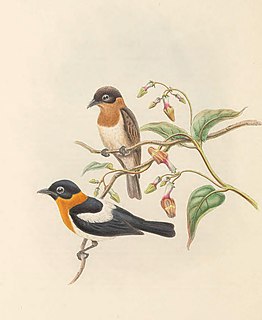
The ochre-collared monarch or rufous-collared monarch is a species of bird in the family Monarchidae. It is found in Yapen and northern New Guinea. Its natural habitats are subtropical or tropical moist lowland forests and subtropical or tropical moist montane forests.
The Espíritu Santo antelope squirrel is a species of antelope squirrel in the family Sciuridae. It is endemic to Mexico, where it is known only from the island of Espíritu Santo in the Gulf of California. The species was originally described by Edward William Nelson and Edward Alphonso Goldman in 1909 as a subspecies of the white-tailed antelope squirrel, a wide-ranging species in the southwestern U.S. and Mexico. In 1938, Arthur H. Howell elevated the subspecies to full species status, on the basis of slightly larger skull proportions and the absence or reduction of the third upper premolar. Studies of DNA and chromosomes have variously suggested close relationships with Harris's antelope squirrels or other subspecies of white-tailed antelope squirrel. A 2007 comparison of DNA and morphological traits suggested the differences between Espíritu Santo squirrels and those on the Baja California peninsula and other islands were not enough to warrant distinct species but rather a subspecies of white-tailed antelope squirrels. Since 2008 the IUCN has similarly recognized the Espíritu Santo antelope squirrel as a subspecies of white-tailed antelope squirrel.
The San José Island kangaroo rat is a subspecies of rodent in the family Heteromyidae. It is endemic to Mexico, where it is found only on San José Island off the east coast of Baja California Sur. is restricted to an area of only 30 km2 in the southwestern coast of San José Island, Lower California, with the population having been drastically reduced in size and being close to extinction No other species of Dipodomys occur in sympatry with D. insularis.

The insular mole is a species of mammal in the family Talpidae. It is found in China and Taiwan, where it is also known as the Formosan blind mole. The species was first described by Robert Swinhoe in 1863.

Pteropus pelagicus is a species of fruit bat in the family Pteropodidae. It includes two subspecies that were formerly recognized as full species— Pteropus insularis and Pteropus phaeocephalus. It is endemic to Micronesia. It is threatened by habitat loss.

The black jackrabbit is a species of mammal in the family Leporidae. Endemic to Mexico, its only known location is Espiritu Santo Island in the Gulf of California. The IUCN has listed this species as a "vulnerable species" because of its restricted range. This taxon is regarded by some authorities as being a subspecies of the black-tailed jackrabbit, found on the mainland of Mexico.
Helicia insularis is a species of plant in the family Proteaceae. It is endemic to Papua New Guinea. It is threatened by habitat loss.
Oligonyx is a genus of moths of the family Noctuidae erected by Shigero Sugi in 1982; the name is a junior homonym of the mantis genus OligonyxSaussure, 1869, and must be replaced, following the International Code of Zoological Nomenclature. Despite that, its only species, Oligonyx vulnerata, was first described by Arthur Gardiner Butler in 1878. It is found in south-eastern Siberia, Korea, Japan, northern and central China.
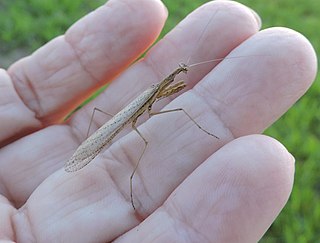
Thespidae is a family of Neotropical insects in the order Mantodea. Following a major revision of this order in 2019, the old-world subfamilies Haaniinae and Hoplocoryphinae, previously placed here, have been upgraded to family level.
The Bismarck crow is a species of crow found in the Bismarck Archipelago. It was considered by many authorities to be a subspecies of the Torresian crow, but is now treated as a distinct species.
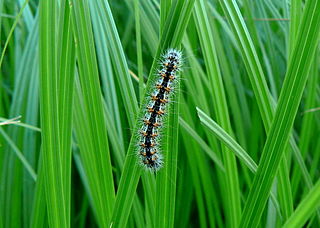
Acronicta insularis, the cattail caterpillar or Henry's marsh moth, is a moth of the family Noctuidae. The species was first described by Gottlieb August Wilhelm Herrich-Schäffer in 1868. It is found from coast to coast throughout the United States and southern Canada.
Oligonyx is a genus of mantises in the family Thespidae.
Oligonyx bicornis is a species of mantid in the family Thespidae.
Oligonyx bidens is a species of mantid in the family Thespidae.
Oligonyx dohrnianus is a species of mantid in the family Thespidae.
Oligonyx maya is a species of mantid in the family Thespidae.

Eucalyptus insularis, commonly known as Twin Peak Island mallee, or North Twin Peak Island mallee, is a species of mallee that is endemic to a small area of southern Western Australia. It has mostly smooth bark, dull green, linear adult leaves, flower buds in group of between nine and twenty or more, white flowers and barrel-shaped fruit.
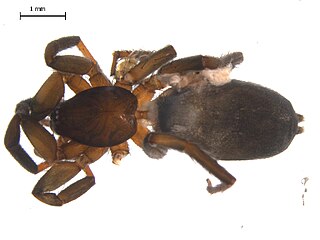
Drassyllus insularis is a species of ground spider in the family Gnaphosidae. It is found in North America.








